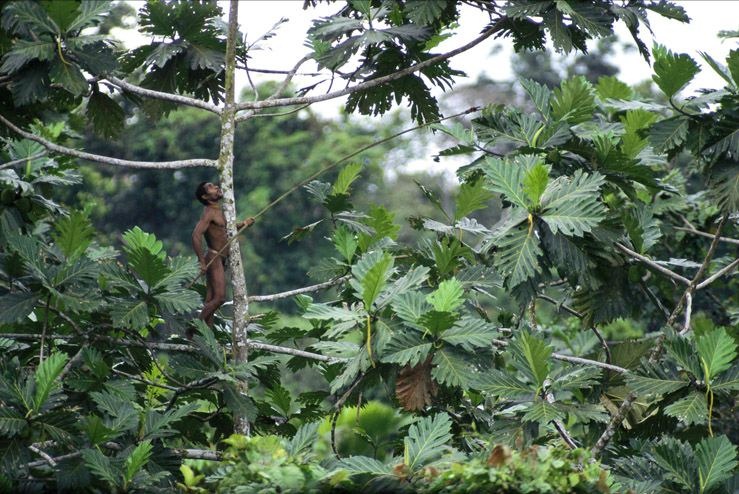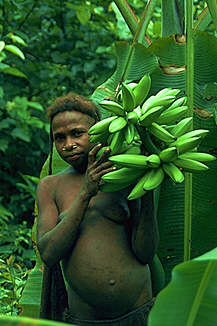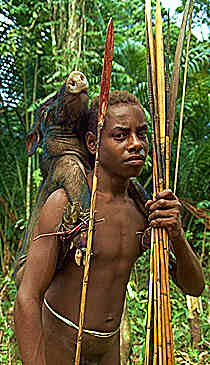Monday, December 3, 2012
The Korowai in Motion
To Change or Not to Change
As Smithsoinian magazine reporter Paul Raffaele takes us on one of his many journey, he shows us the ways and lifestyle of the Korowai people in his 2006 article Sleeping with Cannibals and how it may or may not differentiate with past perceptions of the culture.
Changes:
Changes:
The perception of the groups image of being one of if not the last group of humans to practice cannibalism has come under scope and research once again. After visiting the tribe Raffaele went on to note that, "Cannibalism was practiced among prehistoric human beings,
and it lingered into the 19th century in some isolated South Pacific cultures,
notably in Fiji. But today the Korowai are among the very few tribes believed
to eat human flesh." (Still under questioning...)
...about those outsiders
It was most noted that the culture was at once most outraged by outsiders coming into their land and their territories. Mostly because most of their people never knew anything outside of their rain forest world. Which is understandable because if a purple two legged man standing at 6'4'' with my body structure and not a lick of English came rolling through I'd be throwing him a nice hell-marry!
Raffaele states, "Some
clans are said to fear those of us with pale skin, and Kembaren says many
Korowai have never laid eyes on a white person. They call outsiders laleo
("ghost-demons")." Though he shows a caption picture showing some of the tribe's men's change of mind.
- "I see you're just like us," Lepeadon (right)
told the author after receiving him in the Letin clan treehouse.
Not so Changed....
Their mechanism of defense is not as advanced as their ancestors although they still got a good system. I guess they figure If it's not broke don't fix it! The author reveals that, "a dozen Korowai men hoist our packs and supplies and trudge
toward the jungle in single file bound for the river. Most carry bows and
arrows."
As well as their standards of living, he notes that they still live in houses that are built to sustain the lives of 5-12 and even sometimes 18 persons! Most notably A husband, his wife or wives and unmarried daughters and young children.
Raffaele,
Paul. "Sleeping with Cannibals." Smithsonian Magazine. N.p., Sept.
2006. Web. 01 Dec. 2012.
<http://www.smithsonianmag.com/travel/cannibals.html>.
Disease
Official figures released this month show that the number of people with HIV/AIDS in West Papua has grown by more than 30% in just four months. The figure now stands at more than 17,000. However, doctors and others working in the region contest this number, believing it to be far higher.HIV infection rates in West Papua are 15 times Indonesia’s national average.
The Papua AIDS Prevention Commission (KPA) revealed that the area with the highest increase and overall infection rate was Mimika, home to the giant Grasberg copper and gold mine. The American and British-owned mine, which has destroyed the land of the Amungme and Kamoro tribes, brings many outsiders, including sex workers, into the area.
Some Papuans believe the military deliberately brings prostitutes infected with the virus into tribal areas. Soldiers have been known to offer alcohol and sex workers to tribal leaders in order to gain access to their land and its resources.
Many Papuans avoid seeking help because they don’t trust the Indonesian medical services, believing that they deliberately infect Papuans with the disease. Racist attitudes towards Papuans are commonplace, another reason that Papuans avoid government run clinics.
http://www.survivalinternational.org/news/7294
Food and Trade

The Korowai are excellent hunter-gatherers and horticulturalists who practice shifting cultivation. Since the early 1990s some of them got involved with tour companies selling tours into the Korowai region and generating moderate cash income this way. To consider, they are same people who, less than two decades ago, never knew a world existed outside their jungle.
During the 90s outsiders started exploiting the Korowai region in search of the valuable gaharu (Agarwood). In 1997, 1 kg of gaharu collected by a local Papuan would have a value of about $4.00 when sold to a trader; the gaharu was eventually sold to Middle Eastern and European market for about $1000 a kilo. Gaharu also fuelled a rapid trade in prostitution into the jungles of Papua which has helped contribute to the current AIDS epidemic throughout Papua. Eventually this trade came to an end in 1999.
Several documentaries have been made about the Korowai people and countless articles written. In 1993, a film crew documented the Korowai tree house construction and the practice of cannibalism as a form of criminal justice. In 2011, the Korowai tribe was shown in the BBC documentary Human Planet.









Family
- The family consists of a man, his wife/wives, and his children that aren't married.
- there are no more than 15 persons in one home- most families have two tree houses to accommodate for a large families.
- clan territory is transfered to the male clan members- same with property
- children are mostly raised by their mothers and other males. Babies are breast feed.
- Storytelling, sharing gossip, and teaching songs and sayings that contain practical wisdom are elements of socialization.
- A little girl is actively involved as soon as possible in all female duties. At the age of about ten she is married to a much older man who expects her to be competent with respect to economy, social life, and sexuality
- young girls often receive corporal punishment by their husbands
- When a boy reaches his teens, adult males teach him to discharge a man's duties. Then the boy is informed step by step about intraclan and interclan sensitivities and tensions.
- at 15 boys participate fully in war, etc
- curiosity is discouraged in children
Stasch, Rupert (2001). "Figures of Alterity among Korowai of Irian Jaya: Kinship, Mourning, and Festivity in a Dispersed Society." Unpublished Ph.D dissertation. University of Chicago.
Van Enk, Gerrit. "Korowai." Encyclopedia of World Cultures Supplement. 2002. Encyclopedia.com. 3 Dec. 2012 <http://www.encyclopedia.com>.
Marriage
Some facts about marriage:
De Vries, Lourens (1995). "Spirits and Friends: Expletive Nouns in Korowai of Irian Java." In Tales of a Concave World: Liber Amicorum Bert Voorhoeve,edited by C. Baak, M. Bakker, and D. van der Mey. 178—188. Leiden: Department of Languages and Cultures of South-East Asia and Oceania of Leiden University.
Van Enk, Gerrit. " Korowai." Encyclopedia of World Cultures Supplement. 2002. Encyclopedia.com. 3 Dec. 2012 <http://www.encyclopedia.com>.
- They are exogamous- this means incest is forbidden.
- They are polygamous- this means that can have more than one spouse
- There is a preferment for marrying a mother's mother's brother's daughter...this is similar to widow inheritance Levirate marriage is common in exogamous groups.
- there are required bridal payments, which means tat males marry around the age of thirty to a woman who in her early teens or younger.
De Vries, Lourens (1995). "Spirits and Friends: Expletive Nouns in Korowai of Irian Java." In Tales of a Concave World: Liber Amicorum Bert Voorhoeve,edited by C. Baak, M. Bakker, and D. van der Mey. 178—188. Leiden: Department of Languages and Cultures of South-East Asia and Oceania of Leiden University.
Van Enk, Gerrit. " Korowai." Encyclopedia of World Cultures Supplement. 2002. Encyclopedia.com. 3 Dec. 2012 <http://www.encyclopedia.com>.
Kinship
KINSHIP
Some interesting facts about Kinship for the Korowai:
Some interesting facts about Kinship for the Korowai:
- The mother's brother (mom) and his potential legal and social successors are actively involved in the marriage arrangements for his sisters' children.
- . When a man violates the avoidance taboos with his mother-in-law, his children are believed to become ill.
- Their society is patriarchal- male linage important.
Van Enk, Gerrit. "Korowai." Encyclopedia of World Cultures Supplement. 2002. Encyclopedia.com. 3 Dec. 2012 <http://www.encyclopedia.com>.
Sunday, December 2, 2012
Language
The Korowai are also known as Kolufo. The term Kolufo refers to a people who share one language rather than to a tribal unit, with the patrician being the relevant unit for self-identification. The Kolufo language belongs to the Awyu-Ndumut family of southeastern Irian Jaya, part of the Trans-New Guinea phylum. The Korowai distinguish the dialect of the Lower Becking and Eilanden banks from the Ilol-Kolufo-aup ("Stone-Korowai") spoken in the upriver regions.
Source:
Gerrit Van Enk
2002 Encyclopedia of World Cultures Supplement.Electronic Document.
http://www.encyclopedia.com/doc/1G2-3458100056.html
Source:
Gerrit Van Enk
2002 Encyclopedia of World Cultures Supplement.Electronic Document.
http://www.encyclopedia.com/doc/1G2-3458100056.html
Subsistence
The Korowai are horticulturalists who practice shifting cultivation. The basic food items are sago and bananas. Each clan has its own gardens (yasim) near its tree houses where it also cultivates Ipomoea batatas (khaw), Colocasia tubers (simbelu) and tobacco. Green vegetables, grass, and cane species are collected from the jungle, as well as wild fruits during the appropriate seasons, such as the sweet fruits of the Ponnetia pinniata and wild apples.
Pigs and dogs are the only domesticated animals. Pigs function mainly as objects of exchange and compensation. Dogs are raised for company and hunting, and their teeth are considered extremely valuable. Hunting for wild pigs is done with bows and arrows. Pigs that are caught in pits or traps made with a special fence construction are shot or pierced with spears. Cassowaries are shot or trapped with ropes strung across their paths. Smaller game consist of animals, such as birds, reptiles, rodents, marsupials, and smaller bats. For fishing the Korowai use bows and arrows, poison, and basketlike constructions placed in artificial dams. In precontact days crocodiles were hunted for consumption; they are now hunted for commercial reasons.
Source:
Gerrit Van Enk
2002 Encyclopedia of World Cultures Supplement.Electronic Document.
http://www.encyclopedia.com/doc/1G2-3458100056.html
Pigs and dogs are the only domesticated animals. Pigs function mainly as objects of exchange and compensation. Dogs are raised for company and hunting, and their teeth are considered extremely valuable. Hunting for wild pigs is done with bows and arrows. Pigs that are caught in pits or traps made with a special fence construction are shot or pierced with spears. Cassowaries are shot or trapped with ropes strung across their paths. Smaller game consist of animals, such as birds, reptiles, rodents, marsupials, and smaller bats. For fishing the Korowai use bows and arrows, poison, and basketlike constructions placed in artificial dams. In precontact days crocodiles were hunted for consumption; they are now hunted for commercial reasons.
Source:
Gerrit Van Enk
2002 Encyclopedia of World Cultures Supplement.Electronic Document.
http://www.encyclopedia.com/doc/1G2-3458100056.html
Division of Labor
The division of labor for the Korowai is similar to most native groups. The males are responsible for hunting large game and smaller game can be caught by younger boys. Little children hunt very small animals by using arrows made of sago leaf ribs (Kailon). Rearing pigs and food collection are the responsibility of adult females. Gardening is done by both men and woman; the heavier work is dont by the men and the lighter work is done by women. Other activities shared by both sexes consist of cutting firewood and fishing. The men are responsible for the planting of young sago sprouts. They also do the heavy work of cutting and splitting full-grown sago trees; chiseling and pounding the starch from the inside are done by the women. Women are expected to process the final product, a procedure in which the flour is separated from the washing water through a structure built from the woody shafts of sago leaves. Tree house construction is also a cooperative endeavor done by both sexes. Public religious activities such as the performance of pig sacrifices are reserved for males.
Source:
Gerrit Van Enk
2002 Encyclopedia of World Cultures Supplement.Electronic Document.
http://www.encyclopedia.com/doc/1G2-3458100056.html
Source:
Gerrit Van Enk
2002 Encyclopedia of World Cultures Supplement.Electronic Document.
http://www.encyclopedia.com/doc/1G2-3458100056.html
Mission:
The iCross-Cultural Citizen Project is a cultural anthropology course-based
project meant to raise critical consciousness about the rich cultural diversity in our
indigenous world (in our planet). Being totally aware of the limitations of being outsiders,
we are a group of multidisciplinary undergraduate students who believe in cross-cultural
sensitivity and participatory agency aimed at disseminating information about
indigenous realities as accurately as possible.
Vision:
The iCross-Cultural Citizen Project’s vision is to create an online cross-cultural
space for students, professionals, and youth to learn and exchange cross-culturally
sensitive information about contemporary indigenous experiences. From that outsider
student’s perspective, we will try to theoretically explore possible collaborative solutions
to problems that affect the indigenous populations of our planet. Finally, we hope for the
future creation of a space where indigenous youth can share their experiences and their
realities with us for real mutual collaboration to take place.
Values:
We value the maximization of benefits to indigenous peoples and vulnerable
populations in the world.
We value the respect for persons all over the world.
We value the equal treatment of people, and we are against the exploitation of
vulnerable groups around the world.
We value collaborative cross-cultural learning and critical thinking
Subscribe to:
Posts (Atom)







